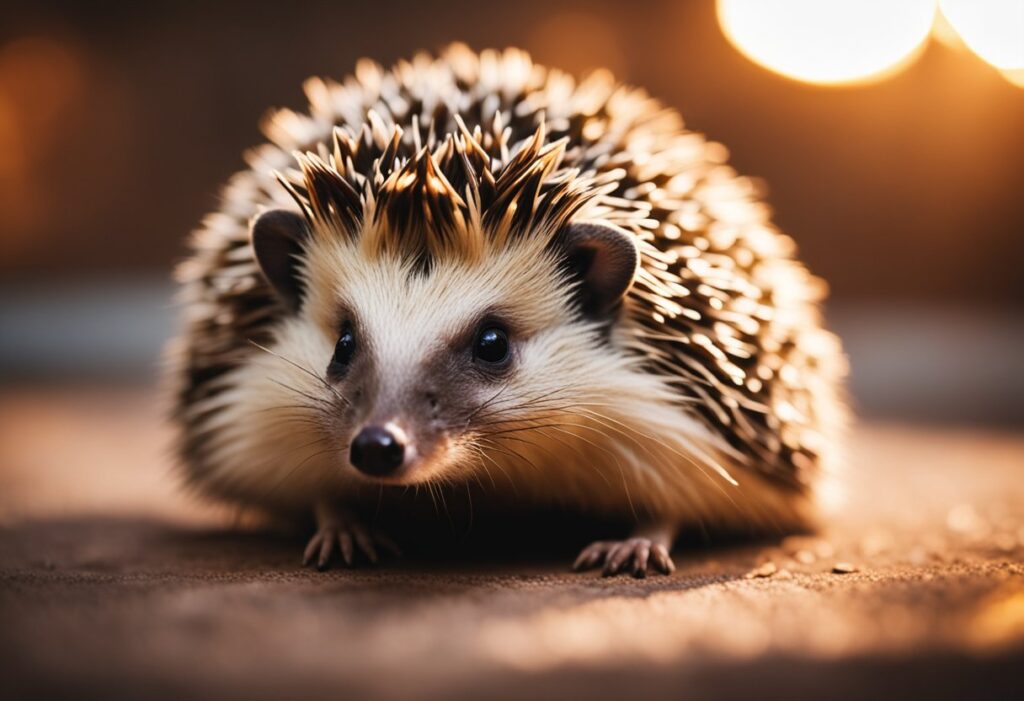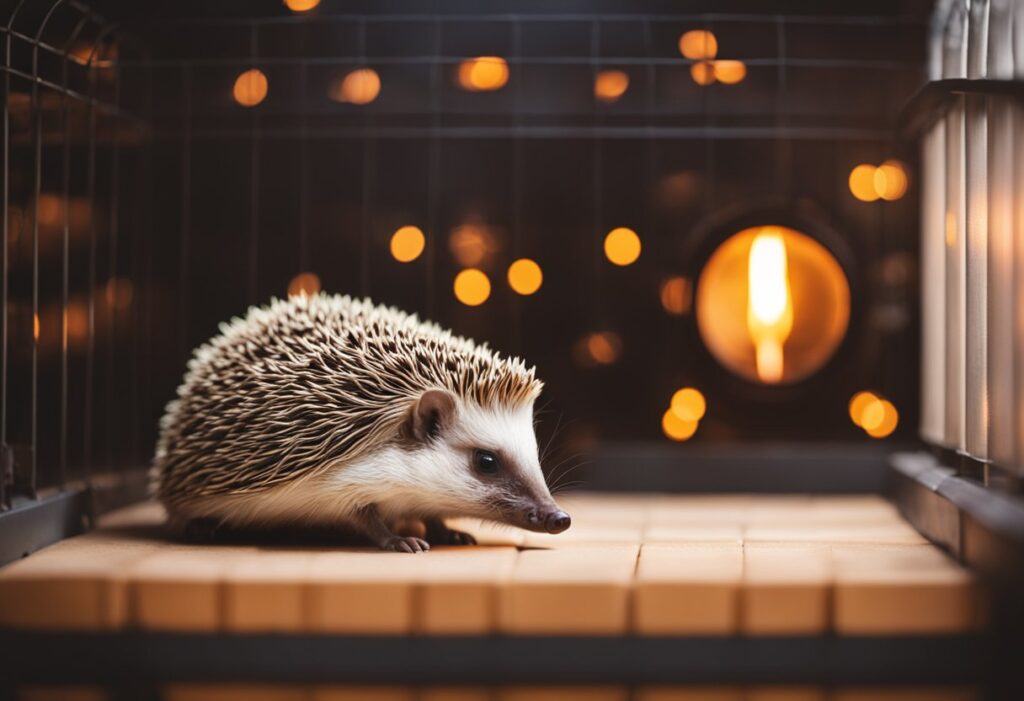Hedgehogs are fascinating creatures that are often kept as pets. However, taking care of them can be a challenge, especially when it comes to providing the right temperature. One common question that hedgehog owners ask is whether or not their pets need heat lamps.

The answer to this question is not straightforward, as it depends on various factors. Hedgehogs are native to Africa, Europe, and Asia, where they live in a range of temperatures. In captivity, they require a temperature range of 72-80°F (22-27°C) to thrive. If the temperature drops below this range, hedgehogs can become lethargic, lose their appetite, and even hibernate. Therefore, providing adequate heating is crucial to their health and well-being.
There are several ways to provide heat for hedgehogs, including heat lamps, ceramic heat emitters, and under-tank heaters. In this article, we will explore the pros and cons of using heat lamps for hedgehogs, as well as alternative heating options. By the end of this article, you will have a better understanding of how to keep your hedgehog warm and comfortable.
Understanding Hedgehog Heating Needs

Importance of Temperature Regulation
As hedgehogs are native to warmer climates, it is important to provide them with a warm and comfortable environment. Hedgehogs are unable to regulate their own body temperature, so it is up to us to ensure that their enclosure is kept at an appropriate temperature.
A temperature range of 72-80°F (22-27°C) is ideal for hedgehogs. Temperatures above 85°F (29°C) can be dangerous and cause heat stroke, while temperatures below 68°F (20°C) can cause hibernation attempts. It is important to monitor the temperature regularly to ensure it stays within this range.
Hedgehog Natural Habitat Climate
Hedgehogs are native to warmer climates, including parts of Europe, Asia, and Africa. In their natural habitat, hedgehogs live in burrows underground to escape the heat of the day and keep warm during colder nights.
When creating an enclosure for a hedgehog, it is important to mimic their natural habitat as much as possible. Providing a hide box or igloo for them to sleep in during the day and night will help regulate their body temperature and keep them comfortable.
In conclusion, hedgehogs require a warm and comfortable environment to thrive. By understanding their heating needs and mimicking their natural habitat, we can provide them with the best possible care.
Heat Lamps for Hedgehogs

If you are a hedgehog owner, you may be wondering if your pet needs a heat lamp. Hedgehogs are native to Africa and Europe, and they are used to living in warm environments. Therefore, it is important to provide them with the right temperature to keep them healthy and happy.
Types of Heat Lamps
There are two main types of heat lamps that you can use for your hedgehog: ceramic heat lamps and infrared heat lamps. Ceramic heat lamps emit heat without light, while infrared heat lamps emit both heat and light. Ceramic heat lamps are more energy-efficient and last longer, but they do not provide any light. Infrared heat lamps, on the other hand, provide both heat and light, which can be beneficial for your hedgehog’s overall well-being.
Benefits of Using Heat Lamps
Using a heat lamp for your hedgehog can provide several benefits. First, it can help regulate your hedgehog’s body temperature, which is important for their health and well-being. Hedgehogs are sensitive to temperature changes, and they can become stressed if their environment is too cold or too hot. A heat lamp can help maintain a consistent temperature in their enclosure.
Second, a heat lamp can help your hedgehog maintain their natural circadian rhythm. Hedgehogs are nocturnal animals, and they need a consistent light and dark cycle to stay healthy. A heat lamp that emits both heat and light can help provide the necessary light for your hedgehog to maintain their natural sleep pattern.
In conclusion, providing your hedgehog with a heat lamp can be beneficial for their health and well-being. However, it is important to choose the right type of heat lamp and to monitor the temperature in their enclosure to ensure that it is not too hot or too cold. By taking these steps, you can help ensure that your hedgehog stays healthy and happy.
Setting Up a Heat Lamp

Choosing the Right Heat Lamp
When it comes to choosing a heat lamp for your hedgehog, it’s important to consider the size of the enclosure, the temperature requirements of your hedgehog, and the wattage of the bulb. We recommend using a ceramic heat emitter, which produces heat without emitting light, as hedgehogs are nocturnal animals and require darkness to sleep.
Proper Installation and Placement
Once you have selected the appropriate heat lamp, it’s important to install it properly and place it in the correct location. We recommend using a lamp fixture with a ceramic socket and a metal guard to prevent your hedgehog from coming into contact with the bulb. The fixture should be securely attached to the top of the enclosure and positioned so that the heat source is approximately 6-8 inches above the bedding material. This will allow for proper heat distribution and prevent the hedgehog from getting too close to the heat source.
Safety Precautions
It’s important to take proper safety precautions when using a heat lamp in your hedgehog’s enclosure. Never use a heat lamp with a plastic socket, as it can melt and cause a fire. Always use a lamp fixture with a ceramic socket and a metal guard. Additionally, make sure that the heat lamp is securely attached to the top of the enclosure and cannot be knocked over by your hedgehog. Finally, always monitor the temperature in the enclosure and adjust the wattage of the bulb as needed to maintain a consistent temperature.
By following these guidelines, you can ensure that your hedgehog stays warm and comfortable without any risk of injury or danger.
Alternative Heating Solutions

Heating Pads
Heating pads are a great alternative to heat lamps for hedgehogs. They provide a constant source of heat without the risk of burning or overheating. We recommend using a thermostatically controlled heating pad to ensure that the temperature remains constant and safe for your hedgehog. It is important to place the heating pad under only a portion of the cage to allow your hedgehog to regulate its body temperature by moving to cooler areas if necessary.
Thermal Blankets
Thermal blankets are another option for providing warmth to your hedgehog. They are made of insulating materials that trap heat and keep your pet warm. We suggest placing the thermal blanket over a portion of the cage to create a warm and cozy area for your hedgehog to snuggle up in. It is important to monitor the temperature to ensure that it does not get too hot and to provide cooler areas for your hedgehog to regulate its body temperature.
Room Heating
If you keep your hedgehog in a room that is kept at a consistent temperature, you may not need to use any additional heating solutions. However, it is important to monitor the temperature to ensure that it remains within a safe range for your hedgehog. We recommend keeping the room temperature between 72-80°F (22-27°C) to ensure that your hedgehog is comfortable and healthy.
Overall, there are several alternative heating solutions to heat lamps that can provide a safe and effective way to keep your hedgehog warm. It is important to choose a heating solution that works best for your hedgehog and to monitor the temperature to ensure that it remains safe and comfortable.
Monitoring and Maintaining Temperature
Thermometers and Thermostats
To ensure that our hedgehogs are comfortable and healthy, it’s essential to monitor and maintain the temperature of their enclosure. We recommend using a thermometer to measure the temperature and a thermostat to regulate it.
A digital thermometer with a probe is ideal as it allows us to take accurate readings from different areas of the enclosure. We can then adjust the heat source accordingly to ensure that the temperature is consistent throughout the enclosure.
A thermostat is also a crucial tool as it enables us to set and maintain a specific temperature range. It will automatically turn the heat source on or off to maintain the desired temperature, which is especially important during colder months.
Regular Temperature Checks
We advise checking the temperature of the enclosure at least twice a day, preferably in the morning and evening. This will help us identify any potential issues with the heating system and ensure that our hedgehogs are comfortable at all times.
It’s also essential to keep a record of the temperature readings to monitor any changes or fluctuations. We can use a chart or table to record the time, date, and temperature readings, allowing us to identify any patterns or issues over time.
In conclusion, monitoring and maintaining the temperature of our hedgehog’s enclosure is crucial to their health and wellbeing. By using a thermometer and thermostat and regularly checking the temperature, we can ensure that our hedgehogs are comfortable and happy in their environment.
Health Considerations
Signs of Overheating
When it comes to hedgehog care, it’s important to keep in mind that they are sensitive to high temperatures. Signs of overheating can include lethargy, panting, and loss of appetite. In severe cases, overheating can lead to heat exhaustion or heat stroke, which can be life-threatening.
To prevent overheating, it’s important to keep the hedgehog’s enclosure at a moderate temperature. A heat lamp can be used to provide warmth, but it’s important to monitor the temperature and ensure that it doesn’t get too hot. A thermometer should be used to check the temperature regularly, and the heat lamp should be turned off if the temperature gets too high.
Hibernation Risks
Hedgehogs are known to hibernate in the wild, and some pet hedgehogs may attempt to hibernate if they are exposed to cooler temperatures. However, hibernation can be dangerous for pet hedgehogs, as they may not be able to survive the process.
To prevent hibernation, it’s important to keep the hedgehog’s enclosure at a consistent temperature. A heat lamp can be used to provide warmth, but it’s important to ensure that the hedgehog is not too close to the lamp and that the temperature is not too high. It’s also important to provide a warm, cozy hiding place for the hedgehog to sleep in.
Overall, it’s important to be aware of the potential health risks associated with using a heat lamp for hedgehogs. By monitoring the temperature and providing a safe, comfortable environment, we can help ensure that our hedgehogs stay healthy and happy.
Frequently Asked Questions
What is the ideal temperature range for a hedgehog’s habitat?
Hedgehogs require a warm and cozy habitat to thrive. The ideal temperature range for a hedgehog’s habitat is between 72°F to 80°F (22°C to 27°C). It is important to maintain a consistent temperature throughout the day and night to ensure their comfort.
Can I use a thermostat with a heat lamp for my hedgehog’s cage?
Yes, using a thermostat is highly recommended when using a heat lamp for your hedgehog’s cage. A thermostat will help regulate the temperature and prevent overheating, which can be harmful to your hedgehog.
What are the best types of heat lamps to use for hedgehogs?
Ceramic heat emitters and radiant heat panels are the best types of heat lamps to use for hedgehogs. These lamps provide a gentle and consistent heat source without emitting light that can disrupt their natural sleep cycle.
Is UV lighting necessary for a hedgehog’s well-being?
No, UV lighting is not necessary for a hedgehog’s well-being. Hedgehogs are nocturnal animals and do not require UV lighting to maintain their health.
How should I heat my hedgehog’s cage to ensure its comfort?
To ensure your hedgehog’s comfort, it is recommended to use a heat lamp or other heating device that provides a consistent and gentle heat source. Place the heat lamp on one side of the cage to create a temperature gradient, allowing your hedgehog to move to a cooler area if needed.
What are some effective methods to keep a hedgehog warm during power outages?
During power outages, it is important to keep your hedgehog warm to prevent them from getting too cold. You can use hot water bottles or microwaveable heating pads to provide temporary warmth. It is also recommended to have a backup generator or alternative heat source on hand in case of an extended power outage.











